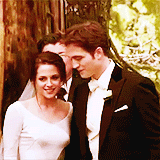onsdag 8 februari 2012
The Visual Effects Supervisors Talks About The Process Of 'Breaking Dawn Part 1 & 2'
From source: FlickeringMyth
“Bill [Condon] told me they were going to break it up in two parts because the book was so large,” recalls American Visual Effects Supervisor John Bruno of his initial meeting with the Oscar-winning writer-director to discuss the cinematic adaptation of The Twilight Saga: Breaking Dawn. Bruno was intrigued by the concept. “Bella [Kristen Stewart] gets married, has vampire sex, becomes pregnant, loses 30 pounds, gets sick, is close to dying, they forcibly get the baby out of her, she dies and comes back as a vampire in Part One; in Part Two, we get to experience everything that happens to her as a vampire. I thought, ‘Well, that’s different. I like this.’” 1275 visual effects shots had to be completed within a schedule of three months. “It was broken down that the wolves would be [the responsibility of Phil] Tippett.” Beyond refining the signature shape-shifting creatures there were two more major issues. “The other things were the ‘Bella Effect’ and the Renesmee Baby, which in the next movie grows rapidly [into an adult].” Bill Condon needed to be guided through the unfamiliar world of visual effects. “Bill said, ‘I trust you know what you’re doing,’” recalls Bruno who had to address an overriding concern for the filmmaker; Condon did not want the performances of his actors to be replaced digitally. “The biggest thing in this whole approach was to never lose the expression and the emotion in the eyes of the characters.”
“In movie one, Bella was going to lose weight and look very bulimic,” states John Bruno who utilized a combination of practical and CGI effects to make the 200 ‘Bella Effect’ shots believable. Under the supervision of John Rosengrant, the creature effects company Legacy Effects made a series of appliances which were added to actress Kristen Stewart during a three hour makeup session; they were designed to sink in her eyes, and enhance her cheek bones, chin, and collarbones. Test footage was shot and sent to Lola VFX which was responsible for squeezing and thinning the image. “The main reason for using the prosthetics was the hope that many shots would be good enough in camera, and it would reduce the digital shot count,” explains Lola VFX Visual Effects Supervisor Edson Williams who had previously collaborated with Bruno on making Magneto (Ian McKellen) and Professor X (Patrick Stewart) look 25 years younger in X-Men: The Last Stand (2006). “It ended up creating more work for us because the appliances stuck out at the temples creating odd shadows that then had to be removed; in addition we had to deform the prosthetics down to where Kristen’s natural temple line existed.”
“Altering Kristen Stewart’s body was incredible challenging,” admits Edson Williams. “Fortunately, Legacy created an absolutely amazing life-size puppet of an emaciated Bella; we constantly referred back to it for the body deformations. Most of the shots had both facial and body deformations so we thinned up Kristen’s forearms and legs, and added bony ridges to her knuckles.” The original reference material had to be abandoned. “During our initial development phase of the ‘Bella Effect’ we viewed images of starving young women. The images were horrifying, and we immediately began to search for another source, something much softer. We ended referencing thin fashion and runway models with very defined jaws and cheekbones.” Adjustments had to be made. “John immediately noticed we were reducing the width of Kristen Stewart’s jawline; once we restored the original width, she immediately appeared more emaciated.” 3D head references were used for every shot. “Lola VFX developed a trick to shrink wrap a 2D image onto tracked 3D geometry. Essentially, we had two 3D heads of Kristen Stewart, one normal and one that has been emaciated in Z-brush. We projected the plate photography onto the normal 3D model; then based on surface normal transferred the colour to the emaciated 3D model. It worked because both models had the same number of vertices, and we were only deforming the orbital ridge and cheekbones.”
“Our biggest challenge was maintaining a consistent look across the shots,” reveals Edson Williams. “Changing the camera position and slight alterations in lighting created huge variations in Kristen’s face, so we would have to adjust the amount of deformations between each cut. Using a 3D tracked [PFtrack] emaciated Kristen Stewart, CyberScan was critical to this consistency and it allowed us to maintain exact placement of her orbital ridge and cheekbones. Eyes were always problematic because we had to sink them back into Kristen’s face without making her look ghoulish. Bill Condon was very particular with the look of Kristen’s eye region. We ended up reducing our initial work so the sunken eyes would not draw too much attention.” John Bruno was pleased with the final result. “Over the last 35 minutes of the movie, one of the characters says, ‘You look terrible.’ Kristen is a good 10 pounds thinner. You would have to A/B the [before and after] pictures to see that. Then there’s a scene where she stands up, lowers her rob and stares at herself in a mirror; her bones and ribs are showing. It gets a gasp from the audience.” Bruno observes, “It’s the big reveal in the movie and it pays off quite well.” Helping the visual effects supervisor was the courageous support of the lead actress. “Kristen was a great sport. What we’re saying to her is, ‘We’re going to make you look not good.’ As an actress her whole thing is about beauty and looking great; what we were going to do was beyond her control and she let us do it.”
Read more here
Source: via Twilightish
Prenumerera på:
Kommentarer till inlägget (Atom)


Inga kommentarer:
Skicka en kommentar